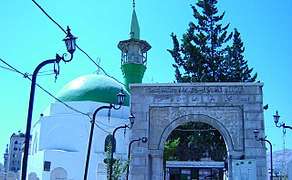Daughters of Husayn ibn Ali
| |
|---|
 |
|
|
The Islamic figure Husayn ibn Ali had three daughters: Ruqayyah (Arabic: رُقَـيَّـة),[lower-alpha 1] Fāṭimah aṣ-Ṣughrá (Arabic: فَـاطِـمَـة الـصُّـغـرَى, "Fatimah the Younger")[2] and Fāṭimah al-Kubrá (Arabic: فَـاطِـمَـة الـكُـبـرَى, "Fatimah the Elder").[3][4][5][6]
Ruqayyah

Ruqayyah (born on the 20th of Rajab, 56 AH – 5 Rabi' al-thani, 60 / 61 AH or 676 CE; died on the 13th of Safar, 60 / 61 AH or 680 / 681 CE),[7] was the daughter of Rubab bint Imra al-Qais ibn Adi bin Aws.[8] Her brothers included Ali Zaynul-Abidin, Ali al-Akbar, and Ali al-Asghar.[4][5][6][9]
Shi'ite narrative
The story of Sakinah is one of the many emotional stories that Shī‘ī Muslims tell about Husayn and his martyrdom at the hands of Yazid's troops. The Battle of Karbala and the subsequent events at the court of Yazid are explained and mourned annually during the commemoration of the 10th of Muharram, also known as ‘Âshûrá’ (Arabic: عَـاشُـورَاء, tenth day). According to these religious narrations, Sakinah suffered from fatigue and thirst on the forced march to Damascus, and later from cold and starvation in Yazid's dungeon.[7]
Journey to Iraq and Shaam
She accompanied her father when he traveled from Mecca to Kufah in Iraq. On the 2nd of Muharram, 61 AH (680 CE), Husain and 72 of his family members and companions were forced to camp in the plains of Karbala by Yazid's army of 30,000 men. Yazid ibn Muawiyyah was the practical Caliph who desired religious authority by obtaining the allegiance of Husain, but the Imam would not give up his principles. On the 10th of Muharram, the Imam's household was attacked, a number of his companions were killed, and the survivors were made captives. The survivors included the Imam's sisters, wives, and daughters, including Sakinah, relatives of companions of the Imam, and his son, Ali Zaynul-Abidin, who did not participate in the battle, due to an illness. Sakinah, as with others, had been grieved over the killings. They had also suffered from thirst.[10]
The survivors were marched by Yazid's army from Karbala to Kufah, where Sakinah received water from a sympathetic woman, and then to Damascus in Shaam. There was a lack of pity from the captors' part during the journey. Even at these times of hardship and misery, Ruqayyah was sympathetic to others, such as her mother, whom she consoled her mother on the death of Ali al-Asghar.[10][11][12]
Death and aftermath
.jpg)
In the dungeon, Sakinah's aunt Zainab bint Ali tried to console her, and said that she would soon meet her father. One night, when Sakinah was asleep, she woke up crying and started to look for her father everywhere. All the women tried to console her so that she would stop crying, but she continued: "O my dear aunt, Where is my father? A few minutes ago I was with my father, and he kissed me and said that "My dear Sakinah you will soon be with me." But where is my father now?" At this, all the women started to cry, and the crying was heard by Yazid at his court. Yazid sent the severed head of Husain to the prison, and when Sakinah received the head of her father, she started to cry even more and held it very tight and asked her father: "Who cut off my father's head, who martyred my father, why are we held as captives?"[13] With these words of sorrow, Sakina was quiet. Everyone thought that Sakinah had finally gone to sleep again, but she had died, at the age of four or five.[7]
Her body was buried in the dungeon. Zaynab held the still child as Ali dug a grave for his sister in the dungeon. Her clothes were burnt in Karbala, and due to injuries, had intermingled with her flesh. Therefore, she was buried in the same burnt, ripped clothes in the dungeon of Shaam. As the grave was being filled after the burial, the mother let out a scream. All of the women huddled around her, and the prison walls began to shake with the cry, "Ya Sakina, Ya Mazloomah!" (O Sakina, O Oppressed one!). Then Yazid decided to release them from prison, allowing them to return to Medinah.[14][15] Rubab would nevertheless come to her grave, placing her cheek on it and cry out, "Speak to me Sakinah. Only a word, my child, speak to me."[11]
Centuries later, an ‘Ālim (Arabic: عَـالِـم, Scholar) had a dream in which Sakinah asked him to move her body from the grave to another site, due to water pouring into her grave. He and some people opened the grave, and saw that ground water was indeed entering the grave, besides that her body was still intact. Sakinah's body was moved from its original burial place, the dungeon, and reburied where her Mosque is now located.[16][17]
Family tree
| Adam | |||
| Noah | |||
| Ibrahim (Abraham) | |||
| Ishmael | Is-haq (Isaac) | ||
| ‘Adnan (b.122 BC)
. . . . . . |
Ya‘qub (Jacob) | ||
| ‘Abdul Muttalib | ‘Isa (Jesus) | Musa (Moses) | |
| ‘Abdullah (d.570 AD) | Abu Talib (d.620AD) | ||
| Muhammad (d.632AD) | |||
| Fatimah (d.11 AH) | ‘Ali (d.661 AD) | ||
| Al-Husain (d.680AD) | |||
| Sakinah / Ruqayyah (d.680AD)[14] | |||
Fatimah as-Sughra
It is believed that there were two daughters of Husayn who had the name 'Fatimah': Fatimah al-Kubra ("Fatimah the Elder") and was 11 years old during the Battle of Karbala, and Fatimah as-Sughra.[3][4][5][6]
As-Sughra was a daughter of Umm Ishaq bint Talhah.[2] It is believed that she was ill and left behind at Medinah, when her father took part in the Battle of Karbala (680 ACE).[18][19] Eventually, she accompanied her aunt Zainab to Shaam. She is believed to have died there, with her grave being in Damascus.[17]
Fatimah al-Kubra
According to the Shī‘ah (Arabic: شِـيـعَـة), Husayn married Fatimah al-Kubra[20] (born 669 ACE) to his brother Hasan's son Abdullah at Karbala, due to a promise that Husayn made to him. The marriage happened just before the battle in which both Husayn and Abdullah got martyred. Fatimah died in the year 736 ACE. As such, she appears not only to have been a contemporary of her father and brother Ali Zaynal-Abidin, but also the later Shi'ite Imams Muhammad al-Baqir and Ja'far al-Sadiq.[3][4][5][6]
 Bab al-Saghir, which contains the grave of Fatimah al-Kubra in Damascus, Shaam
Bab al-Saghir, which contains the grave of Fatimah al-Kubra in Damascus, Shaam- The grave of Fatimah al-Kubra in the Levant
- Gold plated cage made on ground flour over the grave
- A wooden cage made around the grave
Notes
See also
References
- ↑ Arne, Ambros; Stephan, Procházka (2004). A Concise Dictionary of Koranic Arabic. Wiesbaden: Ludwig Reichert Verlag. p. 136. ISBN 3-89500-400-6.
- 1 2 Islamic shi'ite encyclopaedia, Ḥasan Amīn, s.n., 1973 - Religion; "... Fatima; i^u her mother was Umm Ishaq bint Talhah ibn 'Abdullah."
- 1 2 3 "The Role of Women in Karbala". Alimoula110.com. Retrieved 2015-07-02.
- 1 2 3 4 Ihic.org Archived October 16, 2009, at the Wayback Machine.
- 1 2 3 4 Shia.org Archived March 1, 2009, at the Wayback Machine.
- 1 2 3 4 "(A.S.) Network". Imamreza.net. Retrieved 2015-07-02.
- 1 2 3 "3". Nafasul Mahmoom. Qum: Ansariyan Publications. 2005. pp. 388–389.
- ↑ Shaykh Abbas Qummi. Nafasul Mahmoom. p.298.
- ↑ Fortunecity.org Archived February 21, 2009, at the Wayback Machine.
- 1 2 Coej.org Archived February 14, 2011, at the Wayback Machine.
- 1 2 "The Fourth Journey - Kufa to Shaam | The Journey of Tears | Books on Islam and Muslims". Al-Islam.org. 2013-10-28. Retrieved 2015-06-02.
- ↑ Nafs ul Mahmoom by Sheikh ‘Abbas Qummi, Behar ul Anwaar, Vol I by ‘Allamah Sayyad Mohammad Baqir Majlisi and others.
- ↑ "Welcome to www.alicdcentre110.com". Alicdcentre110.0fees.net. Retrieved 2015-06-02.
- 1 2 "ʿALĪ B. ḤOSAYN B. ʿALĪ B. ABĪ ṬĀLEB". ENCYCLOPÆDIA IRANICA. Retrieved 1 August 2011.
- ↑ Donaldson, Dwight M. (1933). The Shi'ite Religion: A History of Islam in Persia and Irak. BURLEIGH PRESS. pp. 101–111.
- ↑ 'Summary of the Tragedy of Sayyeda Ruqayya', Booklet at Ruqayya Mosque, 2008
- 1 2 "Syria". Mailviruskid.tripod.com. Retrieved 2016-10-14.
- ↑ The Light, Volumes 12-13; Bilal Muslim Mission of Tanzania, 1978 - Islam; " ... said that Imam Husain (a.s.) had another daughter named Fatema, we have to point out that she was Fatema Sughra ..."
- ↑ The Immortal Poetry & Mir Anis: With the Versified Translation of a Marsia of Mir Anis; Syed Ghulam Abbas, Mir Babbar Ali Anis, Majlis-e-Milli, Pakistan, 1983 - Elegiac poetry - 368 pages; "Umme Salma loved Husain very much. At the time of Huasin's departure from Madina, she was left there due to her old age and also to look after Fatima Sughra, the ailing daughter of Husain. Na'ni, Umme Salma. 6. AU, Son of Abu Talib ..."
- ↑ "The Story Of Sukaina Bint Al-Hussein A Muslim Heroine". Mathaba.net. 2007-05-07. Retrieved 2015-07-02.
Bibliography
- Momen, Moojan An Introduction to Shi'a Islam, Yale University Press, 1985.